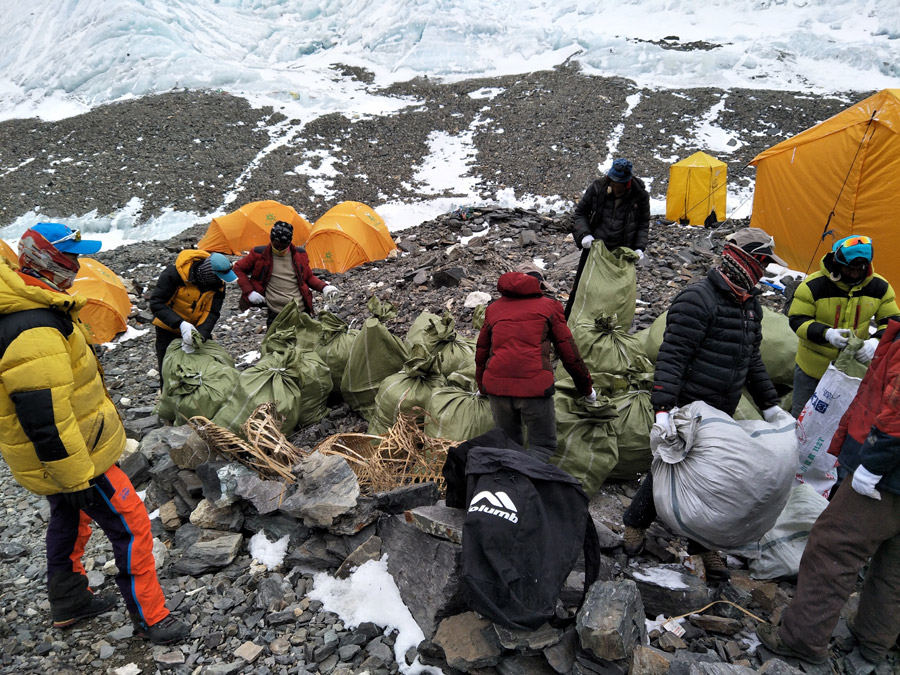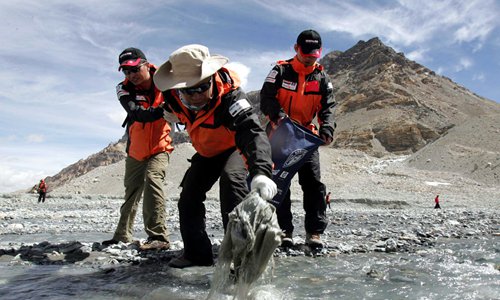
From the People's Daily app.
And this is Story in the Story.
Last year, an environment squad designated at Mount Qomolangma, otherwise known as Mount Everest, was created in an effort keep trash off of the world's most famous peak.
On the north face, climbing season runs from March to May, and once the season ends, a cleanup campaign begins, above 5,100 meters.
So far, the trash unit has hauled away more than 5,000 kilos of perishable garbage, 1,000 kilos of climbing equipment, and over 2,000 kilos of feces.
This year, for the first time, the team will retrieve the bodies of the climbers who died above 8,000 meters, to give them proper burials.
It's a job most people don't want, and one that only a few are qualified to perform, but someone has to do it.
Today's Story in the Story looks at a unique group of mountaineers and climbing guides who keep one of the world’s tallest peaks trash free.

Members of the environmental squad collect trash at base camp on the north face of Qomolangma. (Photo: Xinhua)
When climbing season ends in May at Mount Qomolangma, a dedicated and daring team will begin to clean up the garbage left behind by climbers.
Garbage collection on Qomolangma requires three years of training, according to Cering Dandar, a mountaineer and guide.
"Just picking up a single ring-pull at over 7,000 meters could be a matter of life or death!" he said.
He once spent an entire day wriggling through the ice to get two oxygen tanks and a plastic cookie bag. Falling into a crevice is his worst nightmare.
Cering is one of China's first Tibetan climbing guides. He has climbed the highest summits on seven continents and hiked the North and South poles.
He has a master's degree in media and communications and was the cameraman when the Beijing Olympic torch reached the top of Qomolangma in 2008. He has reached the summit four times.
It was in 2006 during his first ascent when Cering noticed the amount of trash scattered on the mountain.
"Cans, chocolate, oxygen tanks, tents and sleeping bags. The colors just don't belong here where everything should be white and blue," he said.
In 2018, Cering helped create the trash unit. The team has carried out three major clean-ups above 5,200 meters. This year, they will have to do it all over again.
It is almost impossible to clear all of the waste. Some of it is simply unreachable, while the rest is gathered and put into two containers at the camp. A single trash collecting expedition can take eight hours.
The garbage is treated 100 kilometers away from the mountain, and the only road available is a zigzagging path. Yaks, not trucks, are used to make the journey.
Garbage is sorted as recyclable and non-recyclable and handed over to a local nature reserve administration.
As avalanches, blizzards, and altitude sickness remain constant threats, the work environment alone makes it one of the most dangerous jobs on Earth.

Volunteers collect garbage at Mount Qomolangma in May 2006. (Photo: VCG)
The 30-member cleaning crew consists of guides or liaison officers from the climbers' association.
Dondrup is one of only three locals on the team. In the off-season, he is a doctor in Tosanglin village, located at the foot of the mountain. He has picked up trash along the mountain for three years.
"We do a lot of walking. One worker collects only 10 kilograms of garbage each day," he said. He earns just over $700 a month - not much compared with villagers working in other sectors.
"I don't do it for money. My family has lived here for generations. It is my job to protect the mountain," he said.
Above 6,500 meters, only professional mountaineers like Cering can do the job, and at 7,000 meters, even professional climbers face physical limits. Any unnecessary movement is risky and can cause death.
At 8,000 meters, even the guides suggest climbers abandon their equipment, such as oxygen tanks, which weigh about 2 kilos each.
Penma Trinley, deputy director of the Tibetan Mountaineering Association, said the garbage left on the mountain in one year is usually removed during the next.
Abandoned equipment is carried back to Lhasa, where it is auctioned or turned into art.
Every climbing team is given two trash bags, courtesy of the regional sports bureau, and must haul at least eight kilograms of garbage during their descent. Fines are levied if garbage bags weigh less than eight kilograms.
Volunteers and amateur climbers, who often suffer from altitude sickness, have done their part in picking up bottles and plastic bags.
Thanks to new legislation aimed at protecting the environment, regulations that cover climbing, tourism, scientific exploration and engineering projects are in place.
"If I could choose again, I would still become a guardian of the holy mountain,” Cering said.
(Produced by Nancy Yan Xu, Lance Crayon, Brian Lowe, and Da Hang. Music by: bensound.com. Text from China Daily and Global Times.)


